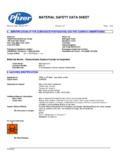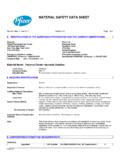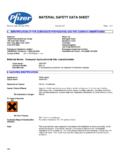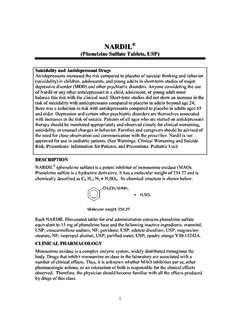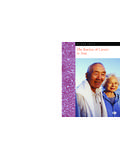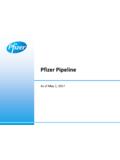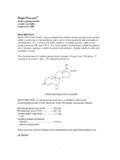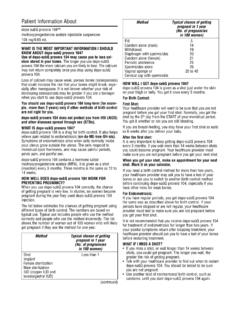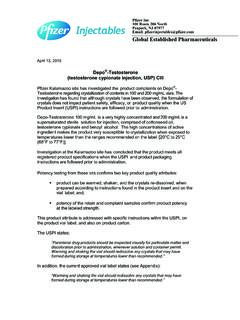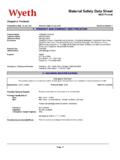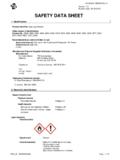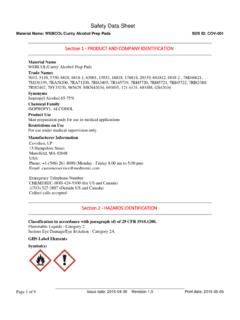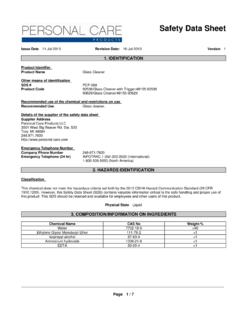Transcription of MATERIAL SAFETY DATA SHEET - Pfizer
1 MATERIAL SAFETY data SHEET . Revision date: 19-Aug-2008 Version: Page 1 of 10. 1. IDENTIFICATION OF THE SUBSTANCE/PREPARATION AND THE COMPANY/UNDERTAKING. Pfizer Inc Pfizer Ltd Pfizer Pharmaceuticals Group Ramsgate Road 235 East 42nd Street Sandwich, Kent New York, New York 10017 CT13 9NJ. 1-212-573-2222 United Kingdom +00 44 (0)1304 616161. Emergency telephone number: Emergency telephone number: CHEMTREC (24 hours): 1-800-424-9300 ChemSafe (24 hours): +44 (0)208 762 8322. Contact E-Mail: MATERIAL Name: Clindamycin Phosphate Topical Solution Trade Name: CLEOCIN T; DALACIN T. Chemical Family: Mixture Intended Use: Pharmaceutical product used as antibiotic agent 2. HAZARDS IDENTIFICATION. Appearance: Colorless solution Signal Word: WARNING. Statement of Hazard: Flammable liquid and vapor. Causes eye irritation. Vapors may cause drowsiness and irritation of the eyes or respiratory tract May cause allergic reaction.
2 Additional Hazard Information: Short Term: May be harmful if swallowed. May cause skin irritation. Vapors irritating to eyes and respiratory tract. Breathing high vapor concentrations may cause central nervous system (CNS). depression resulting in dizziness, light-headedness, headache, nausea, and loss of coordination. Continued inhalation may result in unconsciousness and death. Known Clinical Effects: Individuals sensitive to this MATERIAL or other materials in its chemical class may develop allergic reactions. Clinical use of this drug has caused sore throat, fever, gastrointestinal disturbances, abnormal liver function tests, kidney dysfunction. Pseudomembranous colitis (manifested by watery diarrhea, urge to defecate, abdominal cramps, low-grade fever, bloody stools, and abdominal pain) may also occur. EU Indication of danger: Irritant EU Hazard Symbols: EU Risk Phrases: _____.
3 CLINDAMYCIN PHOSPHATE TOPICAL SOLUTION. MATERIAL SAFETY data SHEET . MATERIAL Name: Clindamycin Phosphate Topical Solution Page 2 of 10. Revision date: 19-Aug-2008 Version: _____. 2. HAZARDS IDENTIFICATION. R10 - Flammable. R36 - Irritating to eyes. R43 - May cause sensitization by skin contact. R67 - Vapors may cause drowsiness and dizziness. Australian Hazard Classification Hazardous Substance. Dangerous Goods. (NOHSC): Note: This document has been prepared in accordance with standards for workplace SAFETY , which require the inclusion of all known hazards of the active substance or its intermediates regardless of the potential risk. The precautionary statements and warnings included may not apply in all cases. Your needs may vary depending upon the potential for exposure in your workplace. 3. COMPOSITION/INFORMATION ON INGREDIENTS. Hazardous Ingredient CAS Number EU EINECS/ELINCS List Classification %.
4 Clindamycin Phosphate 24729-96-2 246-433-0 Xi;R36-43 1. Xn;R22. Isopropyl alcohol 67-63-0 200-661-7 F;R11 50. R67. Xi;R36. Propylene glycol 57-55-6 200-338-0 Not Listed *. Ingredient CAS Number EU EINECS/ELINCS List Classification %. Water, purified 7732-18-5 231-791-2 Not Listed *. Additional Information: * Proprietary Ingredient(s) indicated as hazardous have been assessed under standards for workplace SAFETY . For the full text of the R phrases mentioned in this Section, see Section 16. 4. FIRST AID MEASURES. Eye Contact: Flush with water while holding eyelids open for at least 15 minutes. If irritation occurs or persists, get medical attention. Skin Contact: Remove contaminated clothing and wash exposed area with soap and water. Obtain medical assistance if irritation occurs. Ingestion: Never give anything by mouth to an unconscious person. Wash out mouth with water.
5 Do not induce vomiting unless directed by medical personnel. Seek medical attention immediately. Inhalation: Remove to fresh air and keep patient at rest. Seek medical attention immediately. Symptoms and Effects of Exposure: For information on potential signs and symptoms of exposure, See Section 2 - Hazards Identification and/or Section 11 - Toxicological Information. _____. CLINDAMYCIN PHOSPHATE TOPICAL SOLUTION. MATERIAL SAFETY data SHEET . MATERIAL Name: Clindamycin Phosphate Topical Solution Page 3 of 10. Revision date: 19-Aug-2008 Version: _____. 5. FIRE FIGHTING MEASURES. Extinguishing Media: Use carbon dioxide, dry chemical, or water spray. Hazardous Combustion Products: Emits toxic fumes of carbon monoxide, carbon dioxide, nitrogen oxides, sulfur oxides and other sulfur-containing compounds. Fire Fighting Procedures: During all fire fighting activities, wear appropriate protective equipment, including self- contained breathing apparatus.
6 Fire / Explosion Hazards: Flammable liquid. Vapors will form flammable or explosive mixtures with air at room temperature. Vapors are heavier than air and may travel along surfaces to remote ignition sources and flash back. 6. ACCIDENTAL RELEASE MEASURES. Health and SAFETY Precautions: Personnel involved in clean-up should wear appropriate personal protective equipment (see Section 8). Minimize exposure. Measures for Cleaning / Collecting: Eliminate possible ignition sources ( , heat, sparks, flame, impact, friction, electricity). Contain the source of spill if it is safe to do so. Collect spill with absorbent MATERIAL . Clean spill area thoroughly. Measures for Environmental Place waste in an appropriately labeled, sealed container for disposal. Care should be taken to Protections: avoid environmental release. Additional Consideration for Large Non-essential personnel should be evacuated from affected area.
7 Report emergency Spills: situations immediately. Clean up operations should only be undertaken by trained personnel. 7. HANDLING AND STORAGE. General Handling: Avoid breathing vapor or mist. Avoid contact with eyes, skin and clothing. When handling, use appropriate personal protective equipment (see Section 8). Wash hands and any exposed skin after removal of PPE. Releases to the environment should be avoided. Review and implement appropriate technical and procedural waste water and waste disposal measures to prevent occupational exposure or environmental releases. Potential points of process emissions of this MATERIAL to the atmosphere should be controlled with dust collectors, HEPA filtration systems or other equivalent controls. Storage Conditions: Store as directed by product packaging. _____. CLINDAMYCIN PHOSPHATE TOPICAL SOLUTION. MATERIAL SAFETY data SHEET .
8 MATERIAL Name: Clindamycin Phosphate Topical Solution Page 4 of 10. Revision date: 19-Aug-2008 Version: _____. 8. EXPOSURE CONTROLS / PERSONAL PROTECTION. Refer to available public information for specific member state Occupational Exposure Limits. Clindamycin Phosphate Pfizer OEL TWA-8 Hr: 100 g/m3. Isopropyl alcohol ACGIH Threshold Limit Value (TWA) = 200 ppm TWA. ACGIH Threshold Limit Value (STEL) = 400 ppm STEL. Australia STEL = 1230 mg/m3 STEL. = 500 ppm STEL. Australia TWA = 400 ppm TWA. = 983 mg/m3 TWA. Austria OEL - MAKs Listed Belgium OEL - TWA Listed Bulgaria OEL - TWA Listed Czech Republic OEL - TWA Listed Denmark OEL - TWA Listed Estonia OEL - TWA Listed Finland OEL - TWA Listed Germany - TRGS 900 - TWAs = 200 ppm TWA. = 500 mg/m3 TWA. Germany (DFG) - MAK = 200 ppm MAK. = 500 mg/m3 MAK. Germany - Biological Exposure Limit: Listed Greece OEL - TWA Listed Hungary OEL - TWA Listed Ireland OEL - TWAs = 400 ppm TWA.
9 = 980 mg/m3 TWA. Japan - OELs - Ceilings = 400 ppm Ceiling = 980 mg/m3 Ceiling Lithuania OEL - TWA Listed Netherlands OEL - TWA Listed OSHA - Final PELS - TWAs: = 400 ppm TWA. = 980 mg/m3 TWA. Poland OEL - TWA Listed Portugal OEL - TWA Listed Romania OEL - TWA Listed Romania - Biological Exposure Limit: Listed Slovak Republic - Biological Exposure Limit: Listed Slovenia OEL - TWA Listed Spain OEL - TWA Listed Sweden OEL - TWAs = 150 ppm LLV. = 350 mg/m3 LLV. Propylene glycol Australia TWA = 10 mg/m3 TWA. = 150 ppm TWA. = 474 mg/m3 TWA. Ireland OEL - TWAs = 10 mg/m3 TWA. = 150 ppm TWA. = 470 mg/m3 TWA. Latvia OEL - TWA Listed Lithuania OEL - TWA Listed _____. CLINDAMYCIN PHOSPHATE TOPICAL SOLUTION. MATERIAL SAFETY data SHEET . MATERIAL Name: Clindamycin Phosphate Topical Solution Page 5 of 10. Revision date: 19-Aug-2008 Version: _____. 8. EXPOSURE CONTROLS / PERSONAL PROTECTION.
10 Analytical Method: Analytical method available for clindamycin. Contact Pfizer Inc for further information. Engineering Controls: Engineering controls should be used as the primary means to control exposures. General room ventilation is adequate unless the process generates dust, mist or fumes. Keep airborne contamination levels below the exposure limits listed above in this section. Personal Protective Equipment: Refer to applicable national standards and regulations in the selection and use of personal protective equipment (PPE). Hands: Impervious gloves are recommended if skin contact with drug product is possible and for bulk processing operations. Eyes: Wear SAFETY glasses or goggles if eye contact is possible. Skin: Impervious protective clothing is recommended if skin contact with drug product is possible and for bulk processing operations.
